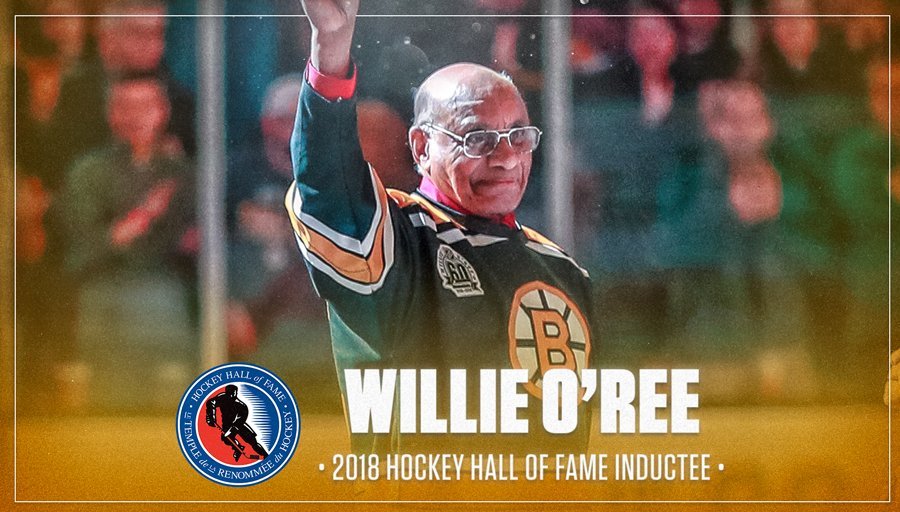
By JOHN McKENNA
As the first black player to take the ice in a National Hockey League game, Willie O’Ree is hockey’s equivalent to Jackie Robinson in multiple ways.
O’Ree broke the NHL’s color barrier on Jan. 18, 1958, skating for the Boston Bruins as they took on the Montreal Canadiens. Although his NHL career was brief, lasting only 45 games from 1958-1961, O’Ree had a lengthy career in the professional ranks. Spanning 19 seasons across five different minor leagues from 1956-1979, O’Ree scored over 900 points in 1,171 games across the QHL, EPHL, WHL, PHL, and AHL, the last of which is still active as the top minor league in North America today.
In spite of his career that spanned nearly a quarter of a century, O’Ree isn’t the household name in hockey that Robinson has become in baseball. Unlike Robinson, neither of the numbers O’Ree wore in the NHL, #22 or #25, have been retired throughout the league. In addition to that, O’Ree wasn’t elected to the Hockey Hall of Fame until 2018, nearly 40 years after he suited up professionally for the final time.
“O’Ree’s Hockey Hall of Fame induction was long overdue. Lanny McDonald, the Hall of Fame’s chairman, told me so when I interviewed him in November,” said Bill Douglas, owner and operator of the Color of Hockey blog.
Douglas believes that like the MLB has done for Robinson’s #42, the NHL should universally retire O’Ree’s #22. “His biggest contributions came after he retired, when he became the NHL’s diversity ambassador. The number of kids he’s reached and the number of pro players who seek his counsel is immeasurable.”
Douglas notes that O’Ree’s induction into the Hall came as a builder rather than as a player, and while most “builders” are people involved directly with teams such as owners, general managers and coaches, O’Ree’s contributions were viewed in a different light. “Folks had to convince the selection committee that O’Ree was a different kind of builder.”
While the NHL doesn’t boast the diversity the NFL and NBA currently do, O’Ree’s courage during and after his playing career set the table for future generations. Grant Fuhr debuted as the first black goaltender in 1981, and he became a key cog in the Edmonton Oilers’ dynasty throughout the 80’s and early 90’s.
Fuhr played parts of 10 seasons in Edmonton, earning six all-star nominations and backstopping the Oilers to five Stanley Cup victories, before becoming the first black player inducted into the Hockey Hall of Fame in 2003. Fuhr has also been named among the top 100 players in NHL history twice, first by The Hockey News in 1998, and once again by the NHL itself at the league’s centennial celebration in 2017.
O’Ree’s Legacy in Today’s NHL

Today, over 25 black players have hit the ice at some point during the 2018-19 NHL season, and among them are some of the league’s brightest stars. P.K. Subban, a defenseman for the Nashville Predators, Wayne Simmonds, a forward for the Philadelphia Flyers, and Kyle Okposo, a forward for the Buffalo Sabres, are some of the most prominent black players in today’s NHL.
Madison Bowey, a defenseman for the Washington Capitals, has donned O’Ree’s #22 since he broke into the NHL in 2017, and has discussed what O’Ree means to him and other black players in the past. “He’s a guy who inspired all of us African Americans and African Canadians. Without him, we wouldn’t be where we are today, or it would have taken a few years to get to where we are today,” said Bowey in an interview with ESPN’s Emily Kaplan last February.
Both on and off the ice, O’Ree’s accomplishments in hockey surpass what most men ever achieve. His courage to take the ice in the face of vitriol and bigotry blazed a trail for some of today’s brightest NHL stars. His post-retirement work as an ambassador of the game had led to numerous outreach groups spreading the game, such as the NHL-sponsored Hockey is for Everyone and the Black Girl Hockey Club.
“The league has put a ton of resources into making hockey more popular for a wider group of people. It’ll take time, but the lack of non-white players in the league won’t be an issue for much longer,” said Shawn M, who has watched the Rangers and Bruins on a regular basis since 1972.
Although his NHL playing career was brief, O’Ree’s impact on the game goes beyond goals and assists. With his induction into the Hockey Hall of Fame last November, O’Ree finally joined the pantheon of hockey legends he deserved to be with all along.
Every day during Black History Month, SI is paying homage to unsung heroes in black sports history
Willie O’Ree was 95 percent blind in his right eye, yet still made NHL history. SI remembers the story of the league’s first black player #BHM pic.twitter.com/d3cmh0FARx— Sports Illustrated (@SInow) February 9, 2019
Interesting. No, he isn’t a household name, as while even though I know squat about baseball, I’m still well aware of who Jackie Robinson is and what legacy he’s left on the sport. I’ve never once heard of this guy, but I suppose every sport has its forgotten legend.
I really enjoy how you are able to compare Willie O’Ree to Jackie Robinson in order to highlight the fact that O’Ree should have gained a similar level of recognition for breaking a sports color barrier.
I also like how your story talks about the progress that has been made for black hockey players in the NHL becoming more apparent and accepted, and the credible sources you used citing O’Ree as an influence on hockey and the NHL. It shows that O’Ree’s effort, though minimally recognized, wasn’t in vain.
Good job!
– Ben